I began this train of thought in my last post, and am picking up the thread here. There we focussed on animals which use the visibility of black juxtaposed with white to draw attention to themselves, to make the point that they are rough and tough and not to be messed with.
There are other reasons to be visible however; while the message from the previous set of animals is mostly directed to other species, an animal feeding in deep shade or on the ground among vegetation might want to let others of its kind - perhaps especially mates or potential mates - know where it is.
 |
| African Fish Eagle Haliaeetus vocifer, Queen Elizabeth NP Uganda. Pairs perch near water, often far apart, and the white-over-black stands out over great distances. |
Paradoxically after all that, there are some circumstances in which black and white can also provide camouflage. For instance an animal against the sky above water will be less visible from below if white, and from above if dark; it is no coincidence that many hunters over water fit this pattern.
 | |
| Little Pied Cormorant Microcarbo melanoleucos and White-necked Heron Ardea pacifica, Lake Cargelligo New South Wales. |
 |
| Pied Kingfisher Ceryle rudis, Queen Elizabeth NP Uganda. |
 |
| Galapagos Penguin Spheniscus mendiculus, Bartolomé. |
The same argument might apply to a small bird feeding in foliage, though in a eucalypt forest at least an olive-green back might be better than black.
 |
| White-naped Honeyeaters Melithreptus lunatus, Jindabyne, New South Wales. These are primarily leaf-gleaners. |
Even very large animals it seems can benefit from being black and white. It is generally accepted that Malay Tapirs are so dramatically black-white-black because this breaks up their outline in dense forest, particularly at night - which is when tigers are mostly abroad.
 |
| Malayan Tapir Tapirus indicus, Adelaide Zoo. Unfortunately the black rump and hind legs aren't visible here. |
One might expect zebras to be included here, but in fact the general consensus now is that the patterns perform a social function. Zebra brains are stimulated by the sight of stripes, and in particular they are driven to groom other zebras. It is thought that the ancestral horse was striped.
 |
| Plains Zebras Equus burchellii, grooming, Etosha NP, Namibia. |
Then, nature being what it is, there are some Very Black and White animals which we can't readily explain. A classic case is the Giant Panda, surely a contender for the Most Familiar Pied Animal. Opinion is divided; some say that the pattern is for visibility in their dense bamboo habitat, or while up a tree - their short-sightedness is cited here, with the need to find a mate in a solitary animal. Others assert the opposite, that tapir-like it is to break up the outline and provide camouflage. But what would be the predator (apart from humans, and we assume that pandas have been black and white for a long time)?
 |
| Giant Panda Ailuropoda melanoleuca, Adelaide Zoo. |
The beautiful Guereza Colobus Monkey seems to me provide the same alternative explanations, though I haven't read anything about this.
 |
| Guereza Colobus Colobus guereza, Queen Elizabeth NP Uganda. Perhaps my favourite monkey! |
I haven't mentioned plants here; in fact the only black and white flower I can think of is a Broad Bean. However Melaleuca means black and white, so that's enough excuse to pay at least token tribute.
 |
| Melaleuca cuticularis, Lake Monjimup, Western Australia. |
Of course we could go on, but I think that's enough for today. Perhaps a change of diet from Pie is required.
Back Monday.




Sorry, but I can't believe that Zebra's don't benefit from the camouflage effect of being stripey in long grass, and also that it makes distinguishing where one animal ends and another begins in a crowded herd situation. The stripes triggering herd bonding behaviour must be a later add-on, surely?
ReplyDeleteJe m'excuse! Looks like I wrote that when I was wearing black and white! What I should have said was: So Madagascar I and II aren't documentaries? Who knew!
ReplyDeleteSue
ReplyDeleteIn my experience zebras tend not to be in long grass a great deal. They are mainly in well grazed areas. I suspect the main reason for this is that other entities, which are very well camouflaged in longish grass, favour canine teeth rather than incisors.
Actually that should probably be 'feline' rather than canine!
Martin
That's OK Susan, I understand your indignation; my suggestion (not original) does seem counter-intuitive. However Martin has put his finger on the key part of the problem with the suggestion that modern zebra patterning is based on camouflage in grassy habitats. The basic tendency of zebras is to congregate in big numbers in exposed areas, where they can keep an eye on approach routes, rather than attempt to hide. This is not to say that the ancestral zebra (the posited stripey ancestral equid) was not say a forest dweller where the stripes may have broken up an outline, a la tiger. In that case your suggestion that the stripe-bonding is derivative could be quite reasonable. In addition they are quite active at night, when the black and white pattern might well assist camouflage in shrubby vegetation in moonlight.
ReplyDeleteAnd thanks for drawing my attention to an important research resource, which I'd overlooked. Perhaps I should consult the Madagascar films...